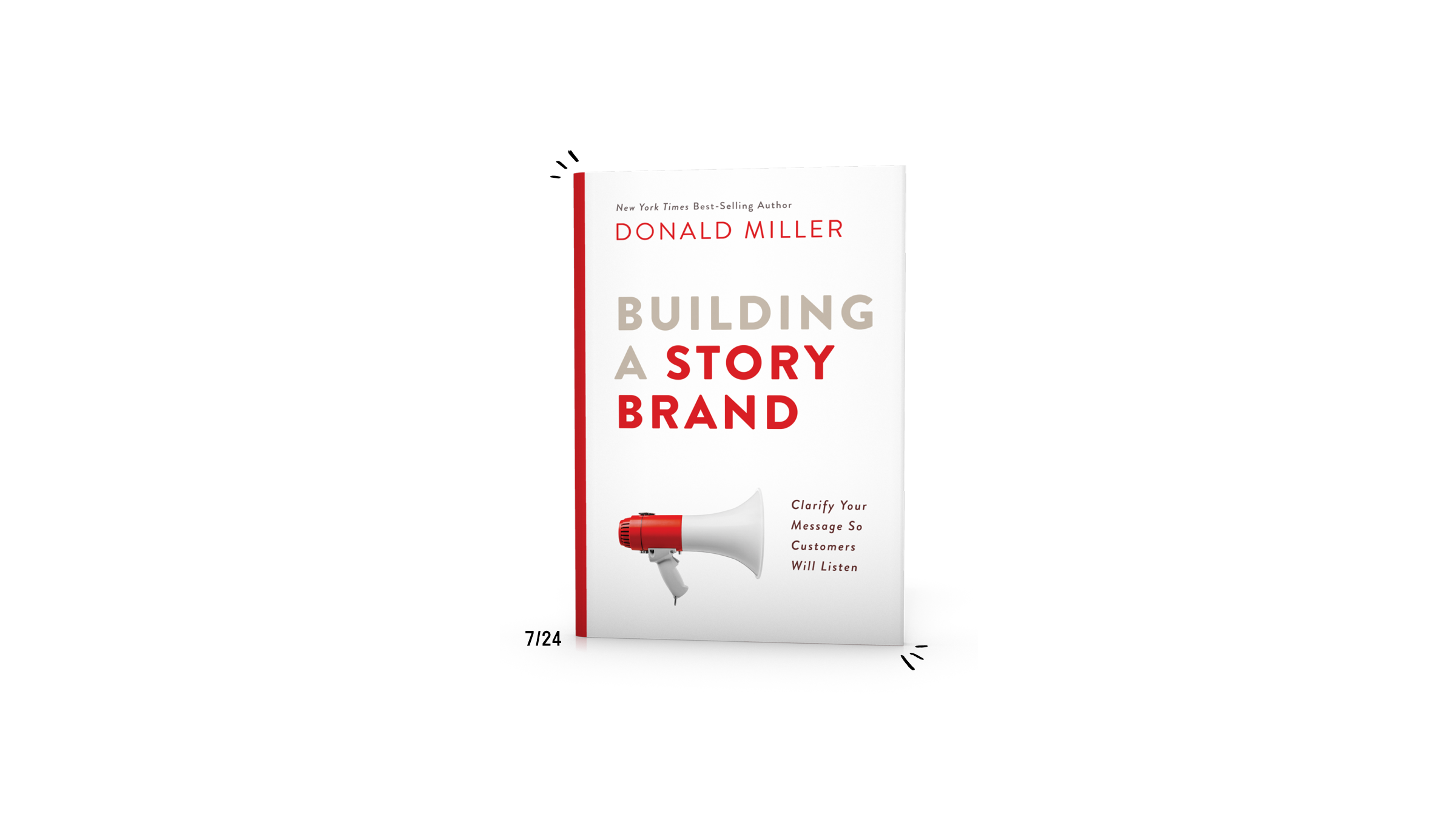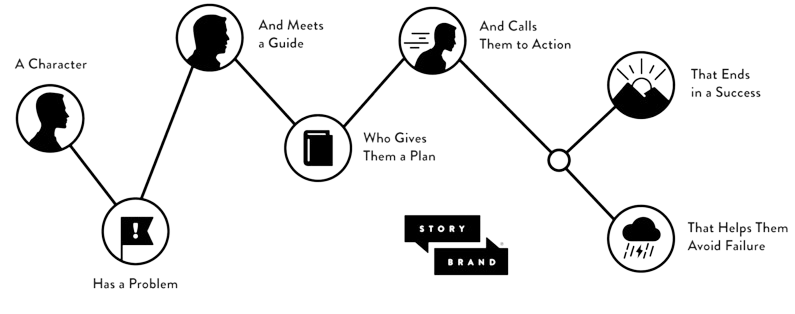Book Takeaways: Building a StoryBrand
April 14, 2024 • Books • Takeaways ⌇ Connect ↗

Recently I have been getting more and more into copywriting and even more so positioning. I never thought I’d enjoy “marketing” this much, but here we are. The StoryBrand makes a more than impelling case to describe where most companies go wrong. And that begins and ends with the simple error in framing. The brand isn’t the hero of the story. The customer is. The brand is merely the guide to get the customer where the way want to go. The art in marketing is to tell a compelling story that’s about them, not us. There are tons of great lessons in this read, so I hope you get as much value out of this summary as I got from reading the 220+ pages of this book. Thanks for putting so much clarity and showing me there is so much work yet to be done so a brand really makes their positioning as clear as a day, Donald Miller. The StoryBrand framework is an incredible asset.
This marks book 7 this year and I couldn’t be happier with being on track to complete one of 2024 goals: reading 24 books. If you know of any more positioning must-reads, shoot them my way!
So without further ado, let’s dive into my top ideas from Building a StoryBrand: Clarify your message so your customers will listen.
Key ideas & takeaways
[01] “If you confuse, you loose.” — no one remembers a brand that creates noise. Confusion is the inability of a prospect to clearly answer where a brand intends to guide them.
[02] The customer is the hero of your story. Your brand is merely the guide to serve the prospects story. Prospects trust a guide that has a plan, which can bridge their path to success (path of hope). If you position your brand as the hero, you will compete with your prospect’s need to be heard & understood. To be seen as a guide use empathy (commonality = seeing as we see ourselves) and authority (demonstrate confidence via testimonials, statistics, awards & logos), so you entice prospects to trust you because you understand them.
[03] Simple = predictable = accessible = relatable. The easiest way the brain can digest information. Mental overload is against our survival instincts and makes us burn too many calories. Complexity is the death of understanding.
[04] Prospects decide based on what they hear, not what you say. A story as a sense-making device to deliver clarity. In a selling process, the initiative duty always lies with the brand, not the prospect.
[05] The average human spends 30% of their time daydreaming, unless they are reading. Attention spans are a limited resource, so use them wisely.
[06] Branding is a simple repeatable message that gets remembered.
[07] “People don’t buy the best products. They buy the products they can understand the fastest.” The job of a business then is to simply deliver on the promises set out in a clearly communicated message.
[08] What Steve Jobs did right with Apple: [1] He identified what the customer wanted (to be seen and heard), [2] He defined the customers challenge (people didn’t recognise their hidden genius) and [3] He offered people a tool to express themselves (computers & smartphones).
[09] Every great story goes through a 7-step process — the SB7 framework. A good story that follows this frame always allows you to answer: [1] What does the hero want?, [2] Who or what is opposing the hero to get what they want? & [3] What will the hero’s life look like if they get what they want? It begins with the hero wanting something.

[10] To avoid noise in your messaging, it should pass the grunt test within 5 seconds (like a caveman), where the prospect should be able to answer these three questions at all times: [1] What do you offer?, [2] How will it make my life better?, [3] What do I need to do to buy it?
[11] The problem is the hook of any hero’s story and is made up of three levels of conflict: external (manifesting the internal), internal (frustrations) and philosophical (about why, ought & shouldn’t) problems. Customers almost only buy solutions to internal problems. An external problem merely manifests the internal problem.
[12] Every story needs a villain = vilifying ideas, which need 4 things to work: [1] Villains need to be the root source, [2] Villains need to be relatable, [3] Villains need to act alone, [4] Villains need to be real.
[13] “Humans take action when their story challenges them to do so”. They usually do so by being presented with what’s at stake … avoiding negative outcomes. The repeating question every prospect asks themself is: “do I have what it takes?” — bring them closer to a hell yes!
[14] Story gap = asking a question that demands resolution between where a character is and what a character wants/desires. A list of desires: Conserving financial resources, conserving time, building social networks, gaining status, accumulating resources, being generous, acquiring meaning…
[15] “Every human is on a transformational journey”. To clearly communicate where your brand is taking people define a before and after interaction pattern with your brand and answer these 4 questions for each: What do they have? What are they feeling? What’s an average day in their life? What is their status? Participating in helping a prospect move closer to their aspirational identity (how they’d like to be described by others), will breed evangelists if you are able to confirm the transformation having taken place as the trusted guide. So between who are prospects moving FROM & TO? Do more than help heroes win, help them transform.
[16] Making a purchase = commitment due to a fear of loss. Use a process (3-6 steps) &/or agreement (cons/fears & pros/hopes list) plan to clearly communicate what steps a prospects needs to take in order to commit.
[17] There are two story motivations/stakes: escape something bad or experience something good. According to Daniel Kahnemann’s prospect theory, people are 2-3 times more likely to act due to loss aversion. Fear appeal to move a prospect towards peace & stability works in 4 steps: [1] Make a prospect understand they are vulnerable, [2] Show a prospect they need to take in order to reduce vulnerability, [3] Be specific about the action they need to take, [4] Challenge them to take that action … What’s the cost of not doing business with you? Those are your stakes.
[18] CTA = closure to journey. There are direct (high risk/commitment requests like “buy now”, “order now” etc.:.) and transitional (low risk offers like downloads, webinars, samples etc.:. which need to stake a claim to your territory, create reciprocity and position yourself as the guide) calls to action. Not asking for a sale = weakness and disbelief in yourself and doesn’t tell the user what action they need to take.
[19] Your website is your elevator pitch. Above the fold should only include images and text that promise [1] An aspirational identity, [2] Promise to solve a problem, [3] State exactly what you do. CTAs should then be placed in a Z-shaped reading pattern from logo to direct CTA, middle of the screen and left bottom for more authority displays. All in all: keep it simple, stupid. People don’t anymore, they scan.
[20] A story’s resolution = success and is all about feeling whole/complete. You can help the guide the hero to win by: [1] Winning with increased status (be esteemed, respected or appealing through special access, scarcity, premium or identity association), [2] Find completeness in the unity something or someone else (being made whole from an external source by reducing anxiety, reducing workload and making more time) & [3] Lead them a a self-realisation of their unlocked potential (helping people accept themselves by offering inspiration, acceptance or transcendence).
[21] “A true mission isn’t just a statement, it’s a way of living and being”. The StoryBrand needs to continue to define the thoughtmosphere of the company culture, so every employee understands the internal and external value prop of the company. Which needs to be a story. Because without one, there is no engagement.
[22] To implement the StoryBrand follow five steps: [1] Create a one-liner (your longline should incite imagination and intrigue by incorporating The Character, The Problem, The Plan & The Success), [2] Create a lead generator (provide enormous about of free value and establish yourself as an authority in your field), [3] Create an automated E-mail drip campaign (remind your customers you exist by talking about their problem, explain a plan of solution and describing how life could look once the problem is solved, call them to a direct action on your website), [4] Collect & tell stories of transformation (apply 5x questions from book) & [5] Create a system that generates referrals.
[23] Don’t play the hero. Play the guide.
Favorite quotes
“Here is nearly every story you see or hear in a nutshell. A CHARACTER who wants something encounters a PROBLEM before they can get it. At the peak of their despair, a GUIDE steps into their lives, gives them a PLAN, and CALLS THEM TO ACTION. That action helps them avoid FAILURE and ends in a SUCCESS … Varying too far from these chords however, means you risk descending into noise.” — Donald Miller
“Believe me, human nature tends toward complacency Finish this process. Beat the competition. Clarify your message. Grow your company. The competition may be more talented than you are, but they will never outwork you if you don’t let them] That’s the one thing you get to control” — Donald Miller
“People want to be involved in a story that is larger than themselves. Brands that give customers a voice in a larger narrative add value to their products by giving their customers a deeper sense of meaning.” — Donald Miller
Final thoughts
If you are into reading or have a goal for 2024 as I do, let’s connect on Literal. You can follow me via @julianpaul — I track my current read and progress daily.
Want to connect? Visit @itsjulianpaul on 𝕏.
Until next time.
Connect
Let’s meet on whatever platform serves your desired outcome best. My digital identity holds all platform intentions. Prefer email? Try contact@julianpaul.me.
Want to stay up to date? RSS ↗ and/or subscribe for email updates. ↓
Socialise with me: LinkedIn | Instagram | 𝕏 | CV

